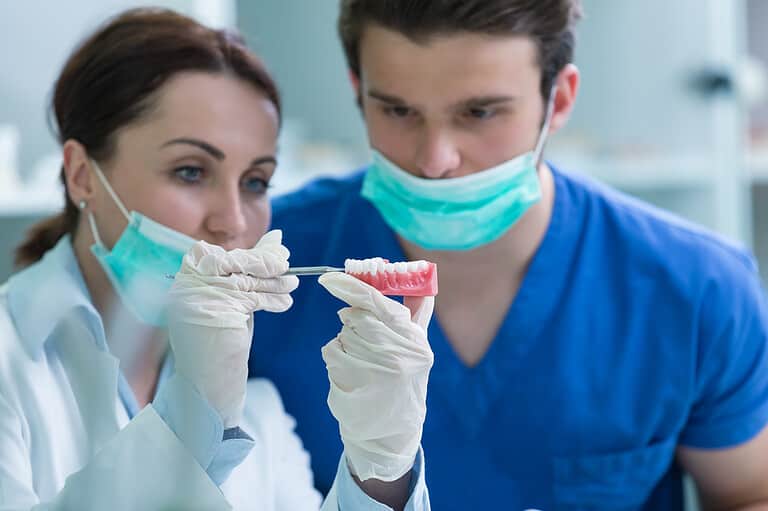A tooth can be seen as a symbol of strength and resilience, and with proper care, it can serve its purpose for a lifetime. However, in some cases, tooth extraction is necessary.
This article will discuss the reasons for which a tooth may need to be removed, provide an overview of the extraction process, and review the best practices for aftercare.
It is hoped that this information will enable the reader to make an informed decision when considering whether or not to extract a tooth.
Reasons for Tooth Extraction
Tooth extraction is necessary in certain cases due to a variety of reasons. Dental extractions may be recommended for impacted wisdom teeth or if an infected tooth cannot be saved through root canal procedures. Simple extractions may be needed if a broken tooth or an adult tooth does not have enough room to align with other teeth or if a tooth infection is too severe and cannot be treated. Extractions may also be necessary when a tooth is so decayed that it cannot be repaired with a dental filling.
The decision to extract a tooth is never taken lightly and is only made when all other treatments have failed. In many cases, the dentist or oral surgeon will try to save the tooth if possible. However, if the tooth is too severely infected or damaged, extraction is the only option. After the extraction, the dentist will discuss options for replacing the extracted tooth, such as a dental bridge, partial denture, or dental implant.
Pros and Cons of Extracting a Tooth
The advantages and disadvantages of performing a dental extraction must be carefully weighed. Extracting a tooth can be beneficial when it is severely decayed or when a root canal treatment cannot be performed. It can also help to maintain the oral health of individuals with periodontal disease. On the other hand, removing a tooth can lead to complications such as gum tissue damage and the formation of an insufficient blood clot in the tooth socket.
There are several factors to consider when deciding whether to extract a tooth. The main pros are the prevention of severe pain, infection, and tooth decay. Extracting a tooth can also help to maintain the overall oral health and ensure that the remaining natural teeth remain in good condition. Conversely, the main cons are the potential for gum tissue damage and the inability to replace the extracted tooth.
Pros and Cons of Extracting a Tooth
- Pros: Prevention of severe pain, infection, and tooth decay; maintenance of overall oral health; preservation of remaining natural teeth.
- Cons: Potential for gum tissue damage; no replacement for the extracted tooth.
- Risks: Inadequate formation of a blood clot in the tooth socket; infection of the tooth socket.
- Benefits: Relief from severe pain; improved oral health; improved overall health.
Alternatives to Tooth Extraction
Alternatives to tooth extraction include root canal therapy, dental fillings, and dental crowns.
Root canal therapy is a dental treatment that is used to save a decayed or damaged permanent tooth.
Dental fillings are also used to fill cavities caused by severe tooth decay or severe gum diseases.
For a more severe case, a dental crown is used to cover the entire tooth, protecting it from further damage and decay.
Before a patient undergoes any extraction procedure, it is important to discuss with a dental professional the available alternatives. The dental professional will be able to assess the severity of the tooth decay and determine the necessary dental treatments.
After the dental appointment, a patient may require an ice pack to reduce swelling and/or pain.
It is also important to be aware of the risk of dry sockets, which can occur after an extraction procedure.
The Extraction Process
The extraction process typically begins with the administration of a local anesthetic to the affected area. Following this, a dental professional may choose to employ one of two types of tooth extraction: surgical or simple.
If a surgical extraction is needed, the dentist will make an incision to remove the tooth. After the tooth is removed, the area may be covered with a sedative dressing.
With a simple extraction, the dentist will use forceps to remove the tooth.
In either case, the patient will be advised to rinse with warm water and avoid using electric toothbrushes in the affected area.
A follow-up appointment will be scheduled to check the healing process. If necessary, root canal therapy may be recommended.
The cost of a tooth extraction varies depending on the type of procedure and the dentist’s fee. It is important to discuss the possible costs with the dentist beforehand.
Ultimately, the decision to extract a tooth depends on the individual situation and should be made in consultation with a dental professional.
Preparing for Recovery
Recovery from a tooth extraction may require certain steps to be taken in order to ensure a successful outcome. It is important to understand the risks of infection and dental pain that may come with this involved procedure. It is also important to be aware of the post-operative discomfort that may include jaw pain, tooth sensitivity, and swelling. To help minimize any discomfort, orthodontic treatment and emergency treatment may be needed. Additionally, sedation options such as nitrous oxide can be used to help reduce pain and anxiety.
Taking the proper steps in preparation for recovery is essential in achieving a healthy smile. By following the necessary steps, the risk of infection and discomfort can be minimized. It is important to be patient with the healing process and to follow the instructions of a dental care provider. With the right preparation and care, a successful recovery is within reach and can result in a beautiful, healthy smile.
Aftercare Tips
Once the tooth extraction procedure has been completed, it is important to follow the aftercare tips provided by the dental care provider to ensure a successful recovery. These tips include:
- Keeping the mouth clean: Regular brushing and flossing are essential to maintain the health of the surrounding teeth, as well as the baby tooth, overcrowded teeth, or asymptomatic teeth that may have been removed.
- Avoiding hard foods: Eating soft, easy-to-chew foods helps to prevent the neighbouring teeth from being damaged, as well as reducing the possibility of severe tooth pain.
- Using a block for tooth extraction: Applying a block for tooth extraction to the actual tooth structure can help to prevent the formation of additional teeth and promote the healing process.
Key Takeaways
In conclusion, tooth extraction is a common dental procedure that can be necessary for a variety of reasons. It should only be pursued when the benefits outweigh the risks, and it is important to be aware of the alternatives that may be available.
The extraction process itself should be completed carefully and with great consideration for the patient’s comfort and health. Following the procedure, proper aftercare and a period of recovery should be observed to ensure the best possible outcome.
All in all, tooth extraction is a serious but sometimes necessary procedure that should be approached with caution and care. Coincidentally, this is the best way to ensure a positive outcome for all those involved.
At Ashfield Family Dental, located in Ashfield, NSW, we understand that tooth extraction can be a scary and stressful experience. That’s why we strive to provide our patients with the best possible care and attention during the process. Our experienced and knowledgeable staff will make sure that you are comfortable and informed every step of the way. If you are considering tooth extraction, contact us today to learn more about the procedure and how we can help.




